

Skeleton Coast. A map of the Namibian homelands.

The Skeleton Coast is the coastal region bordering the Atlantic Ocean to the west and Kaokoveld and Damaraland to the east. One of many rusting ship hulls along the Skeleton Coast.
Welcome to KEO. KEO. Is the name of a proposed space time capsule which was to have been launched in 2003 carrying messages from the citizens of present Earth to humanity 50,000 years from now, when it would re-enter Earth's atmosphere.
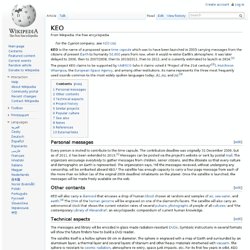
It was later delayed to 2006, then to 2007/2008, then to 2010/2011, then to 2012, and is currently estimated to launch in 2014. [ 1 ] The project KEO claims to be supported by UNESCO (who it claims voted it "Project of the 21st century" [ 2 ] ), Hutchison Whampoa , the European Space Agency , and among other institutions. Its name represents the three most frequently used sounds common to the most widely spoken languages today, / k / , / e / , and / o / . [ 3 ] [ edit ] Personal messages Every person is invited to contribute to the time capsule. . [ edit ] Other contents KEO will also carry a diamond that encases a drop of human blood chosen at random and samples of air , sea water , and earth . [ 4 ] The DNA of the human genome will be engraved on one of the diamond's facets.
Svalbard Global Seed Vault. The Svalbard Global Seed Vault (Norwegian: Svalbard globale frøhvelv) is a secure seedbank on the Norwegian island of Spitsbergen near Longyearbyen in the remote Arctic Svalbard archipelago, about 1,300 kilometres (810 mi) from the North Pole.[4] Conservationist Cary Fowler, in association with the Consultative Group on International Agricultural Research (CGIAR),[5] started the vault to preserve a wide variety of plant seeds that are duplicate samples, or "spare" copies, of seeds held in gene banks worldwide.
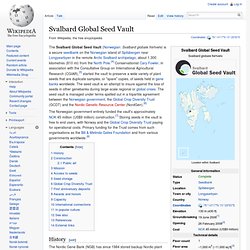
The seed vault is an attempt to insure against the loss of seeds in other genebanks during large-scale regional or global crises. The seed vault is managed under terms spelled out in a tripartite agreement between the Norwegian government, the Global Crop Diversity Trust (GCDT) and the Nordic Genetic Resource Center (NordGen).[6] Crypt of Civilization. Crypt of Civilization interior contents The Crypt of Civilization is a sealed airtight chamber located at Oglethorpe University in Brookhaven, Georgia, in Metro Atlanta.
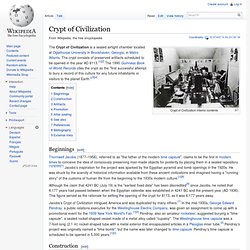
Immortality Drive. Westinghouse Time Capsules. Westinghouse's 1964 - 1965 World's Fair time capsule exhibit 1939 Time Capsule sketch Construction[edit] The two time capsules are bullet-shaped, measure 90 inches (2.29 m) in length, and have an exterior casing of about eight and three-eighths inches (21.1 cm) in diameter.[2] Time Capsule I weighs about 800 pounds (363 kg), while Time Capsule II weighs about half that.[3] Time Capsule I was made of a non-ferrous alloy called Cupaloy, created especially for this project.
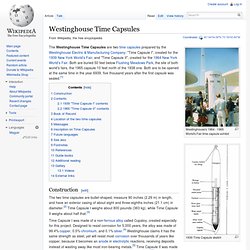
Designed to resist corrosion for 5,000 years, the alloy was made of 99.4% copper, 0.5% chromium, and 0.1% silver.[4] Westinghouse claims it has the same strength as steel, yet will resist most corrosion over thousands of years like copper, because it becomes an anode in electrolytic reactions, receiving deposits instead of wasting away like most iron-bearing metals.[5] Time Capsule II was made of a stainless steel metal called "Kromarc", supplied by U.S. Top 10 Incredible Time Capsules. I have always loved the concept of time capsules and even made one when I was a kid out of a shoebox and buried it in my backyard.
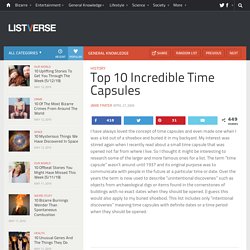
My interest was stirred again when I recently read about a small time capsule that was opened not far from where I live. So I thought it might be interesting to research some of the larger and more famous ones for a list. The term “time capsule” wasn’t around until 1937 and its original purpose was to communicate with people in the future at a particular time or date. Over the years the term is now used to describe “unintentional discoveries” such as objects from archaeological digs or items found in the cornerstones of buildings with no exact dates when they should be opened. (I guess this would also apply to my buried shoebox).